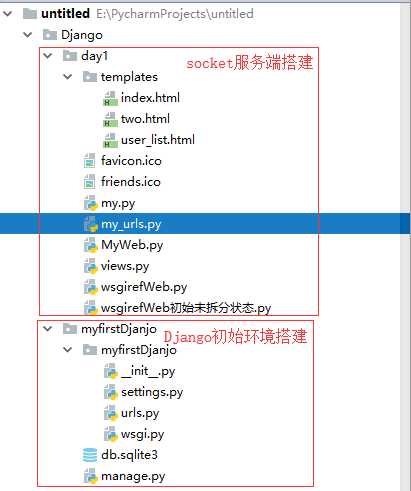Django底层原理简介与安装
Posted yangzhizong
tags:
篇首语:本文由小常识网(cha138.com)小编为大家整理,主要介绍了Django底层原理简介与安装相关的知识,希望对你有一定的参考价值。
Django环境目录搭建一栏:

利用wsgiref模块封装好的socket搭建服务端:
#利用wsgiref模块封装好的socket演示操作(例如accept ecv) #也可以实现socket服务端的功能 from wsgiref.simple_server import make_server #拆分开之后需要导入关联相应表格 import my_urls from views import * #分到views里面 # def index(response): # return ‘ok‘ # # def time(response): # return ‘time‘ # # def error(response): # return ‘404‘ #分到my_urls里面 # urls=[ # (‘/index‘,index), # (‘/time‘,time), # # ] def my_server(environ,start_response): #这里就不需要再accept、recv了,因为封装好了,只需要对接收数据进行处理就好 #environ是个字典:把请求头里所有的东西都切割出来了,不用再手动进行处理 #start_response是个函数:响应头信息HTTP/1.1 200 OK Content-Type:text/html #取请求的地址: # print(environ[‘PATH_INFO‘]) # ‘PATH_INFO‘: ‘/ ‘,默认是空 类似于:GET /index HTTP/1.1 访问时输入什么就会返回什么 # conn.send(b‘HTTP/1.1 200 OK Content-Type:text/html ‘)类似于这个功能 start_response(‘200 OK‘,[(‘Content-Type‘,‘text/html‘)]) # return [b‘Hello wsgiref_socket‘] #到这里就可以模拟MyWeb.py里面的socket服务端功能了 func=None #遍历取出路由列表里面的各个元组值 # for url in urls: for url in my_urls.urls: #判断用户请求的地址是不是写在路由里面的地址 if url[0] == environ[‘PATH_INFO‘]: func=url[1] #相当与 func=index 或者 func=time break #判断是否为空 if func: response=func(environ) #即 index(environ) else: response=error(environ) #wsgiref规定返回值就是要写在列表里面 return [response,] if __name__ == ‘__main__‘: my=make_server(‘127.0.0.1‘,8002,my_server) print(‘监听8002端口‘) my.serve_forever()
my_urls路由配置:
import views urls=[ (‘/index‘,views.index), (‘/time‘,views.time), (‘/user_list‘,views.user_list), (‘/favicon.ico‘,views.favicon) ]
templates渲染html模板(和路由层对应):
1.index.html
<!DOCTYPE html> <html lang="en"> <head> <meta charset="UTF-8"> <title>index界面</title> </head> <body> <img src="https://goss.veer.com/creative/vcg/veer/1600water/veer-136737644.jpg" alt="index"> </body> </html>
2.time.html
<!DOCTYPE html> <html lang="en"> <head> <meta charset="UTF-8"> <title>Title</title> </head> <body> @@[email protected]@ </body> </html>
3.user_list.html
<!DOCTYPE html> <html lang="en"> <head> <meta charset="UTF-8"> <title>用户列表</title> <style> th { background: gray; } td { border: 1px solid black; width: 200px; height: 50px; text-align: center; } th { border: 1px solid black; width: 200px; height: 50px; text-align: center; } </style> </head> <body> <table style="border: 1px solid black;border-collapse: collapse;"> <thead> <tr> <th>id</th> <th>用户名</th> <th>密码</th> </tr> </thead> <tbody> {% for user in user_list %} <tr> <td>{{user.id}}</td> <td>{{user.name}}</td> <td>{{user.password}}</td> </tr> {%endfor%} </tbody> </table> </body> </html>
views视图配置:
import pymysql #jinja2是模板渲染(用于去渲染user_list.html中的文件) from jinja2 import Template #把wsgiref里面的time index error 函数拆分过来 def index(response): # return ‘ok‘ #从template里面调取网页(里面设定要响应返回给客户端的内容) with open(‘templates/index.html‘,‘r‘,encoding=‘utf-8‘) as f: data=f.read() return data.encode(‘utf-8‘) def time(response): # return ‘time‘ import datetime now = datetime.datetime.now().strftime(‘%Y-%m-%d %X‘) with open(‘templates/two.html‘, ‘r‘, encoding=‘utf-8‘) as f: data = f.read() data = data.replace(‘@@[email protected]@‘,now) return data.encode(‘utf-8‘) def error(response): return ‘404‘.encode(‘utf-8‘) def favicon(request): with open(‘favicon.ico‘,‘rb‘) as f: data=f.read() return data def user_list(response): conn=pymysql.connect( host=‘127.0.0.1‘, port=3306, user=‘root‘, password=‘root‘, database=‘test‘ ) #不传参拿到是元组,传参之后得到的是字典 cursor=conn.cursor(cursor=pymysql.cursors.DictCursor) cursor.execute(‘select * from user‘) user_list=cursor.fetchall() print(user_list) #user_list列表[{‘id‘:1,‘name‘:yangzhizong,‘password‘:123},{...}] #取到user_list.html模板 with open(‘templates/user_list.html‘,‘r‘,encoding=‘utf-8‘) as f: data=f.read() #jinja2的应用,生成一个模板对象,需要传字符串 template=Template(data) #template是个对象,就是user_list.html data=template.render(user_list=user_list) #调用对象的render方法,传入参数完成对html文件的渲染 return data.encode(‘utf-8‘)
待完善。。。
以上是关于Django底层原理简介与安装的主要内容,如果未能解决你的问题,请参考以下文章